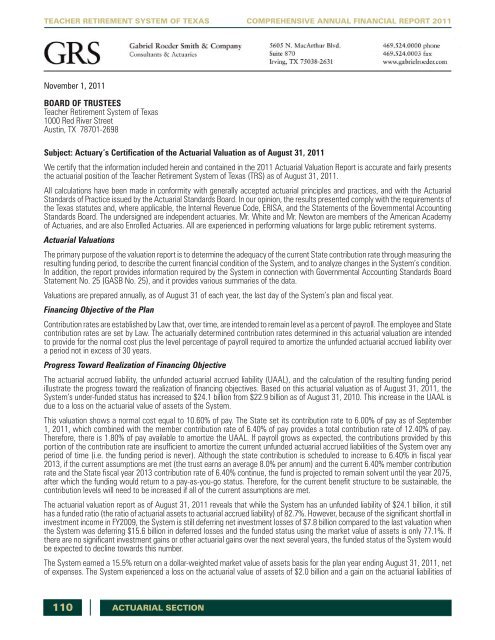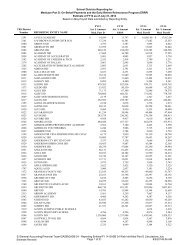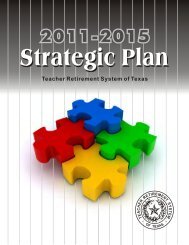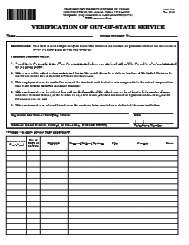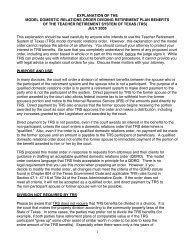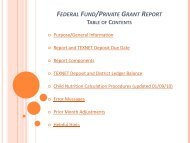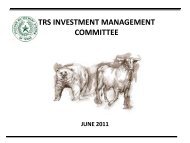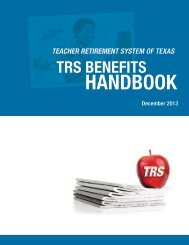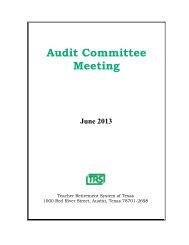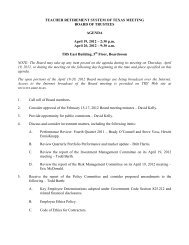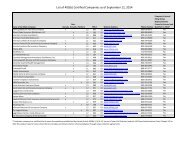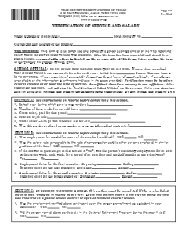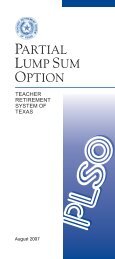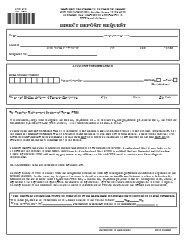TRS 2011 Comprehensive Annual Financial Report
TRS 2011 Comprehensive Annual Financial Report
TRS 2011 Comprehensive Annual Financial Report
You also want an ePaper? Increase the reach of your titles
YUMPU automatically turns print PDFs into web optimized ePapers that Google loves.
TEACHER RETIREMENT SYSTEM OF TEXAS COMPREHENSIVE ANNUAL FINANCIAL REPORT <strong>2011</strong><br />
November 1, <strong>2011</strong><br />
BOARD OF TRUSTEES<br />
Teacher Retirement System of Texas<br />
1000 Red River Street<br />
Austin, TX 78701-2698<br />
Subject: Actuary’s Certification of the Actuarial Valuation as of August 31, <strong>2011</strong><br />
We certify that the information included herein and contained in the <strong>2011</strong> Actuarial Valuation <strong>Report</strong> is accurate and fairly presents<br />
the actuarial position of the Teacher Retirement System of Texas (<strong>TRS</strong>) as of August 31, <strong>2011</strong>.<br />
All calculations have been made in conformity with generally accepted actuarial principles and practices, and with the Actuarial<br />
Standards of Practice issued by the Actuarial Standards Board. In our opinion, the results presented comply with the requirements of<br />
the Texas statutes and, where applicable, the Internal Revenue Code, ERISA, and the Statements of the Governmental Accounting<br />
Standards Board. The undersigned are independent actuaries. Mr. White and Mr. Newton are members of the American Academy<br />
of Actuaries, and are also Enrolled Actuaries. All are experienced in performing valuations for large public retirement systems.<br />
Actuarial Valuations<br />
The primary purpose of the valuation report is to determine the adequacy of the current State contribution rate through measuring the<br />
resulting funding period, to describe the current financial condition of the System, and to analyze changes in the System’s condition.<br />
In addition, the report provides information required by the System in connection with Governmental Accounting Standards Board<br />
Statement No. 25 (GASB No. 25), and it provides various summaries of the data.<br />
Valuations are prepared annually, as of August 31 of each year, the last day of the System’s plan and fiscal year.<br />
Financing Objective of the Plan<br />
Contribution rates are established by Law that, over time, are intended to remain level as a percent of payroll. The employee and State<br />
contribution rates are set by Law. The actuarially determined contribution rates determined in this actuarial valuation are intended<br />
to provide for the normal cost plus the level percentage of payroll required to amortize the unfunded actuarial accrued liability over<br />
a period not in excess of 30 years.<br />
Progress Toward Realization of Financing Objective<br />
The actuarial accrued liability, the unfunded actuarial accrued liability (UAAL), and the calculation of the resulting funding period<br />
illustrate the progress toward the realization of financing objectives. Based on this actuarial valuation as of August 31, <strong>2011</strong>, the<br />
System’s under-funded status has increased to $24.1 billion from $22.9 billion as of August 31, 2010. This increase in the UAAL is<br />
due to a loss on the actuarial value of assets of the System.<br />
This valuation shows a normal cost equal to 10.60% of pay. The State set its contribution rate to 6.00% of pay as of September<br />
1, <strong>2011</strong>, which combined with the member contribution rate of 6.40% of pay provides a total contribution rate of 12.40% of pay.<br />
Therefore, there is 1.80% of pay available to amortize the UAAL. If payroll grows as expected, the contributions provided by this<br />
portion of the contribution rate are insufficient to amortize the current unfunded actuarial accrued liabilities of the System over any<br />
period of time (i.e. the funding period is never). Although the state contribution is scheduled to increase to 6.40% in fiscal year<br />
2013, if the current assumptions are met (the trust earns an average 8.0% per annum) and the current 6.40% member contribution<br />
rate and the State fiscal year 2013 contribution rate of 6.40% continue, the fund is projected to remain solvent until the year 2075,<br />
after which the funding would return to a pay-as-you-go status. Therefore, for the current benefit structure to be sustainable, the<br />
contribution levels will need to be increased if all of the current assumptions are met.<br />
The actuarial valuation report as of August 31, <strong>2011</strong> reveals that while the System has an unfunded liability of $24.1 billion, it still<br />
has a funded ratio (the ratio of actuarial assets to actuarial accrued liability) of 82.7%. However, because of the significant shortfall in<br />
investment income in FY2009, the System is still deferring net investment losses of $7.8 billion compared to the last valuation when<br />
the System was deferring $15.6 billion in deferred losses and the funded status using the market value of assets is only 77.1%. If<br />
there are no significant investment gains or other actuarial gains over the next several years, the funded status of the System would<br />
be expected to decline towards this number.<br />
The System earned a 15.5% return on a dollar-weighted market value of assets basis for the plan year ending August 31, <strong>2011</strong>, net<br />
of expenses. The System experienced a loss on the actuarial value of assets of $2.0 billion and a gain on the actuarial liabilities of<br />
110 ACTUARIAL SECTION


